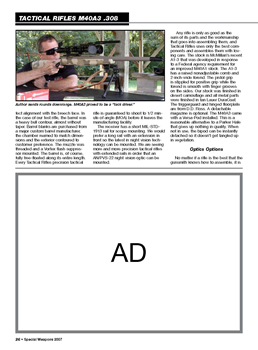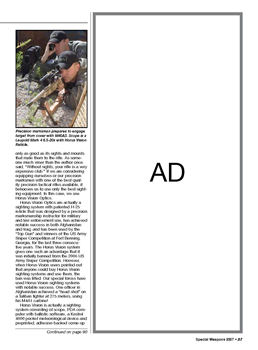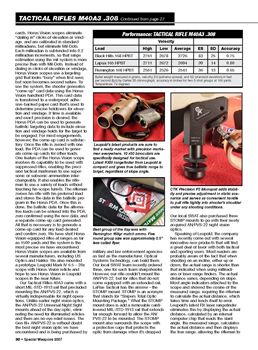
Tactical Rifles M40A3
By Charlie Cutshaw
Tactical Rifles isn’t one of the best-known manufacturers of custom precision tactical rifles, but if our test sample is any indication, they soon will become very well known. Tactical Rifles, part of Dow Arms, produces both bolt action and semiautomatic precision tactical rifles in calibers ranging from .223 to .325 Winchester. While Tactical Rifles uses components from manufacturers such as Remington 700 bolt action receivers, it is the care with which they are assembled that places Tactical Rifles in the top tier of custom manufacturers. In fact, Tactical Rifles produces a rifle and caliber combination for just about any law enforcement or military tactical purpose, from close quarters battle (CQB) to long-range precision shooting at distances of 1,000 meters and beyond.

Gun Details
Our test rifle is Tactical Rifles’ latest product that the company designates M40A3. While not an exact clone of the Marine Corps M40A3, the Tactical Rifles product actually improves on the USMC version in several ways. The heart of any precision rifle is the barrel and receiver assembly. Tactical Rifles begins with the tried and true Remington 700 receiver and then polishes it so that it’s so smooth in operation as to defy description. Bolts are trued in the action to be in perfect alignment with the breech face. In the case of our test rifle, the barrel was a heavy bull contour, almost without taper. Barrel blanks are purchased from a major custom barrel manufacturer, the chamber reamed to match dimensions and the exterior contoured to customer preference. The muzzle was threaded and a Vortex flash suppressor mounted. The barrel is, of course, fully free-floated along its entire length. Every Tactical Rifles precision tactical rifle is guaranteed to shoot to ½ minute of angle (MOA) before it leaves the manufacturing facility.
The receiver has a short MIL-STD-1913 rail for scope mounting. We would prefer a long rail with an extension in front so the latest in night vision technology can be mounted. We are seeing more and more precision tactical rifles with extended rails in order that an AN/PVS-22 night vision optic can be mounted.
Any rifle is only as good as the sum of its parts and the workmanship that goes into assembling them, and Tactical Rifles uses only the best components and assembles them with loving care. The stock is McMillan’s recent A1-3 that was developed in response to the Federal agency requirement for an improved M40A1 stock. The A1-3 has a raised nonadjustable comb and 2-inch-wide forend. The pistol grip is stippled for positive grip while the forend is smooth with finger grooves on the sides. Our stock was finished in desert camouflage and all metal parts were finished in tan Lauer DuraCoat. The triggerguard and hinged floorplate are from D.D. Ross. A detachable magazine is optional. The M40A3 came with a Versa-Pod installed. This is a reasonable alternative to Parker Hale that gives up nothing in quality. When not in use, the bipod can be instantly detached so it doesn’t get tangled up in vegetation.

Optics Options
No matter if a rifle is the best that the gunsmith knows how to assemble, it is only as good as its sights and mounts that mate them to the rifle. As someone much wiser that than the author once said, “Without sights, your rifle is a very expensive club.” If we are precision marksmen with one of the best quality precision tactical rifles available, it behooves us to use only the best sighting equipment. In this case, we use Horus Vision Optics.
Horus Vision Optics are actually a sighting system with patented H-25 reticle that was designed by a precision marksman instructor for military and law enforcement use, has achieved notable success in both Afghanistan and Iraq, and has been used by the “Top Gun” and winners of the US Army Sniper Competition at Fort Benning, Georgia, for the last three consecutive years. The Horus Vision system gives one such an advantage that it was initially banned from the 2006 US Army Sniper Competition. However, when Horus Vision users pointed out that anyone could buy Horus Vision sighting systems and use them, the ban was lifted. Our special forces have used Horus Vision sighting systems with notable success. One officer in Afghanistan achieved a “head shot” on a Taliban fighter at 275 meters, using his M4A1 carbine!

Horus Vision is actually a sighting system consisting of scope, PDA computer with ballistic software, a Kestrel 4000 pocket meteorological device and preprinted, adhesive-backed come-up cards. Horus Vision scopes eliminate “dialing in” clicks of elevation or windage, and are calibrated in standard milliradians, but eliminate Mil-Dots. Each milliradian is subtended into 0.2 milliradian increments, so that range estimation using the mil system is more precise than with Mil-Dots. Instead of dialing in clicks of elevation or windage, Horus Vision scopes use a targeting grid that looks “busy” when first seen, but soon becomes second nature. To use the system, the shooter generates “come-up” card data using the Horus Vision handheld PDA. This card data is transferred to a waterproof, adhesive-backed paper card that’s used to determine precise holdovers for elevation and windage. If time is available and exact precision is desired, the Horus PDA can be used to generate ballistic targeting data to include elevation and windage holds for the target to be engaged. For most engagements, hover, the come-up card is satisfactory. Once the rifle is zeroed with one load, the PDA can be used to generate come-up cards for other loads. One feature of the Horus Vision scope involves its capability to be used with suppressed rifles, enabling the precision tactical marksman to use supersonic or subsonic ammunition interchangeably. It also enables the rifleman to use a variety of loads without touching his scope turrets. The rifleman zeroes his rifle with his preferred load and stores the data in the ballistic program in the Horus PDA. Once this is done, the ballistic data for the alternative loads can be entered into the PDA, zero confirmed using the new data, and a separate come-up card generated. All that is necessary is to generate a come-up card for any load desired and confirm zero. We have shot Horus Vision-equipped rifles at ranges as far as 1500 yards and the system is the most precise we have encountered. Horus Vision scopes are available from several manufacturers, including US Optics and Hakko. We also mounted a prototype Leupold Mark IV 6.5 – 20x scope with Horus Vision reticle and hope to see Horus Vision in Leupold scopes in the near future.
Our Tactical Rifles 40A3 came with a short MIL-STD-1913 rail that precluded mounting the AN/PVS-22, which is virtually indispensable for night operations. Unlike earlier night vision optics, the AN/PVS-22 Universal Night Sight mounts ahead of the day optics, eliminating the need for illuminated reticles and there are no eye relief issues. The Gen III+ AN/PVS-22 is without a doubt the best night vision optic we have encountered and is being purchased by military and law enforcement agencies as fast as the manufacturer, Optical Systems Technology, can build them. Our local SWAT team recently ordered three, one for each team sharpshooter. However, our rifle couldn’t mount the AN/PVS-22, but for rifles that do not come equipped with and extended rail, LaRue Tactical has the answer – the STOMP mount. STOMP is an acronym that stands for “Sniper Total Optic Mounting Package.” What the STOMP mount does is add a removable cantilevered MIL-STD-1913 rail that extends far enough forward to allow the AN/PVS-22 to be mounted. The STOMP mount also surrounds the scope with a protective cage that protects the optic from damage when it’s dropped. Our local SWAT also purchased three STOMP mounts to go with their newly acquired AN/PVS-22 night vision optics.
Speaking of Leupold, the company has recently come out with several innovative new products that will find a great deal of favor with both tactical and sporting users. Most readers are probably aware of the fact that when shooting on an incline, either up or down, the actual range is shorter than that indicated when using milliradians or laser range finders. The actual distance varies, depending on slope. Most angle indicators attached to the scope and showed the cosine of the measured range, requiring the rifleman to calculate the actual distance, which takes time and lends itself to error. Leupold’s latest RX laser rangefinder eliminates this by displaying the actual distance, calculated by an internal computer chip that reads the slant angle, the measured range, calculates the actual distance and then displays the true range, allowing the rifleman to instantly compensate. In conjunction with a Horus Vision reticle, the rifleman will be able to instantly deliver accurate fire on any target he can see. Needless to say, the Leupold rangefinder compensates for smoke, rain, fog and reflection and is accurate to within one yard. It is also the most compact laser rangefinder we have seen. The RX-III rangefinder we used in conjunction with this article is fully armored, waterproof and ranges to 1200 yards. The forthcoming RX-IV adds a digital compass and ranging capability of 1500 yards. We predict that Leupold’s RX rangefinders will be snapped up by our military and law enforcement precision tactical marksmen as fast a Leupold can manufacture them. For operations in mountains and other areas requiring shots to be taken at acute angles, the RX-III and RX-IV will soon be commonplace.

Leupold has also announced a couple of other new items that are a boon to precision tactical rifleman. One is the company’s new 10×50 tactical binoculars. These lightweight waterproof and fogproof binoculars are powerful enough and have sufficient light transmission to bring out detail, and for tactical team scanning by spotters and observers. For those that are so equipped, the reticle can be rotated to compensate for viewing angle. Like all Leupold products, the optics are crystal clear and the light transmission is truly remarkable. Some have stated that 10x binoculars are to powerful for tactical use do to narrow field of view and stability issues, but these Leupold 10x binoculars are a perfect match to the precision tactical marksman’s rifle scope, being the same magnification as that most marksmen use. We had no stability issues and while the field of view at 100 yards was somewhat less that our 7×50 binoculars, the view was just as clear and the difference in being able to see details that were not clear with the 7x50x more than made up for any loss of field of view. The binoculars are rubber armored in Coyote Tan. The other new item is Leupold’s Zero Point Magnetic Illuminated Boresighter. This neat little gadget attaches to the muzzle of the rifle and doesn’t touch the bore. Using it is simple, and it is compatible with any caliber and just about any scope height. The Boresighter can also be used at the range to achieve a one-shot zero. Space precludes our going into details on the Zero Point’s exact procedures for use, but it really works. We have to wonder why someone hadn’t thought of this before.
Just prior to testing, we were sent a new and innovative product for CTK Precision. This patent pending device, called the P3 Ultimate Monopod, is a quick detach monopod that fits any rifle by attaching to the rear swivel stud. An adapter for AR-type precision rifles is also available. Some rifles come equipped with monopods, as they add stability in some scenarios, but most do not and for those shooters who want a monopod, the P3 is just the ticket. The P3 Ultimate Monopod is CDC machined from billet aluminum and hard coat anodized. When the P3 is attached to the rifle, the bottom of the mounting screw takes the place of the sling swivel adapter. There are threaded side mounts and studs for those who might wish to use a side-mounted sling. The P3 Monopod has both gross and fine adjustments. Gross adjustment is attained by rotating a locking nut so the spring-loaded leg can be lowered. Once the gross adjustment is achieved, turning the monopod a quarter turn counterclockwise locks it in place. The monopod is fine tuned using a threaded segment with a rotating Delrin foot. When collapsed, the P3 Ultimate Monopod extends only a little over 2 inches below the stock. The monopod has rubber pads to protect the rifle stock. When not in use as a monopod, the devise serves as a handy grip to pull the rifle back into the shooter’s shoulder.
Range Time
With our rifle set up, we headed for the range. We tested the M40A3 with Black Hills, Lapua and Remington match ammunition. We should not that the M40A3’s trigger was among the best we have ever experienced with zero creep or backlash and virtually no movement before breaking like the proverbial glass rod at just 2.5 pounds. We were told by Tactical Rifles personnel that they had already done the “break in” work for us. This involves shooting 10 single rounds and cleaning after each shot. The next recommended step is to clean after every 5 shots for an additional 30 or so rounds. This is recommended procedure for just about every precision rifle, tactical or match, and it pays dividends in accuracy and longevity because copper fouling is minimized and is easier to remove. We tested our M40A3 with Black Hills 168-grain, Lapua 165-grain and Remington 168-grain match ammunition. Nothing but match grade ammunition should ever be shot through a precision rifle like this one. All ammo delivered excellent results, but the best single group of approximately 0.5 of an inch less a called flyer was achieved with Remington Match ammunition.
In the final analysis, Tactical Rifles has built a superb shooting machine that rivals the best of the breed. It is well made, smooth and reliable in operation and extremely accurate. That about says it all and one really can’t ask for much more in a precision tactical rifle. Our sole complaint is the absence of a MIL-STD-1913 rail for mounting the latest in night vision optics, but LaRue Tactical’s STOMP mount solves that minor issue. The Tactical Rifles M40A3 is one of the finest precision tactical rifles we have tested, and we have tested quite a few over the years.